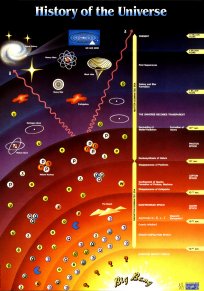Antimatter at the beginning of the Universe
According to the
theory of the Big Bang![]() the Universe
originated about 15 billion years ago from a large "explosion" which produced
an equal amount of matter and antimatter.
the Universe
originated about 15 billion years ago from a large "explosion" which produced
an equal amount of matter and antimatter.
| Fig. 1: The history of the
Universe according to the theory of the Big Bang. (Credit: CERN (photo-di/9108002)) |
But where is antimatter now? Why it is so rare? Understanding the reasons for this cosmic imperfection is one of the main tasks of astrophysics, cosmology and particle physics.
We think that at the beginning of the Universe there was an
equal number of particles and antiparticles. They
annihilated![]() each other into
radiations but were replenished in successive collisions. In
its first moments, the Universe was very small and particles and radiations
were continuously interacting and the Universe was quite opaque.
each other into
radiations but were replenished in successive collisions. In
its first moments, the Universe was very small and particles and radiations
were continuously interacting and the Universe was quite opaque.
About 10-34 seconds after the Big Bang there was a phase of transition,
at the end of which a very small excess of matter over antimatter was generated:
for each billion of antiparticles there was one billion plus one of particles.
After this transition the Universe continued its expansion while its temperature
was decreasing. At about 10-5 s the temperature was so low that it
was not possible to recreate new particle-antiparticle pairs. Then all
antiparticles annihilated in particle-antiparticle collisions: all that remained
was that relatively small number of particles in excess; everything else had
disappeared into radiations.
The precise mechanism which allowed matter to survive is not completely
understood. The motivation may derive from a small difference in physical
properties.
The Russian physicist
Andrei
Sakharov hypothesized in 1967 the conditions under which this could happen.
It required a subtle property, the so-called
violation of CP![]() .
.
We should mention that even if the presence of antimatter at large has not been found, the possibility that it exists cannot be excluded.
